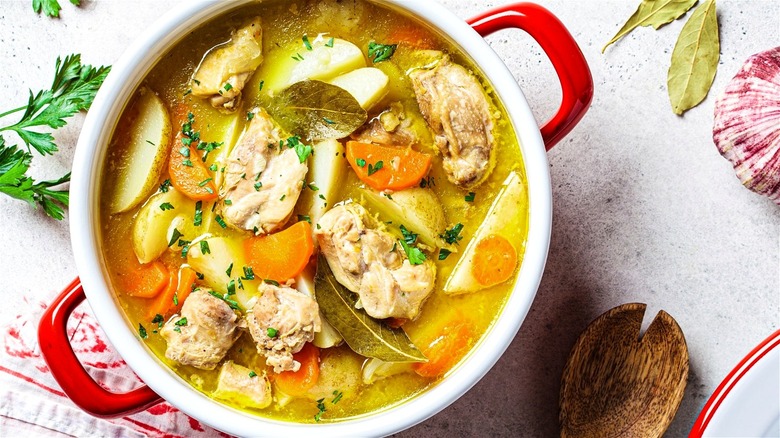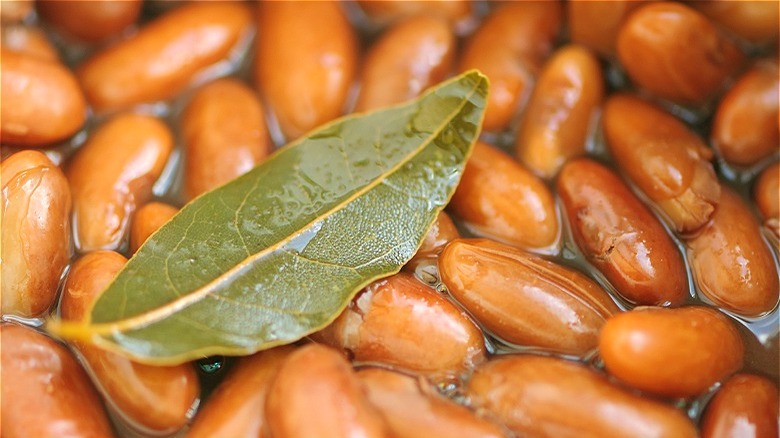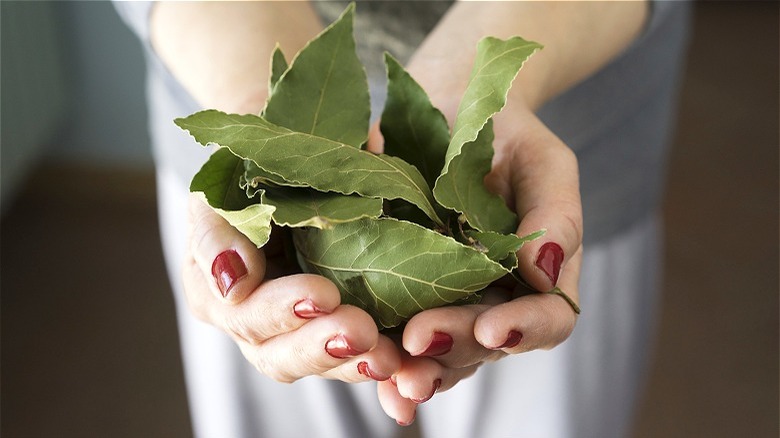The Reason Bay Leaves Are Always Removed From Dishes
What a sad place the world would be if we couldn't breathe life into our favorite recipes by adding the suggested seasonings and spices. Imagine not being able to add the warm flavor notes of cinnamon and clove to your favorite applesauce spice cake, or leaving out the salt, pepper, and thyme from your preferred beef stew recipe. Luckily we have instant access to a plethora of flavor options every time we go to the grocery store.
Our nation's love for seasonings runs deep too: Volza claims America is the leading importer of spices. In an article detailing the lack of spice farming in the U.S., NPR notes some of the most popular spices used today. While you probably use your fair share of vanilla beans, pepper, and mustard like the rest of the country, you may also have a small jar of dried bay leaves tucked away somewhere in your pantry.
Typically used in slow-cooked soups and stews, Escoffier School of Culinary Arts states bay leaves come from the bay laurel tree which is typically grown in the Mediterranean and usually dried whole since the leaves store well and provide a similar level of flavor compared to their fresh counterparts.
Most at-home chefs follow the mysterious recommendation to discard bay leaves after using them. Before we unveil the reasoning behind that notion, let's uncover why we use bay leaves in the first place.
Bay leaves deepen the flavors of your favorite meals
While you contemplate which out of 15 hearty soups and stews to make this weekend, there's a solid chance many of them call for a bay leaf or two. Yet how do these mysterious leaves serve as flavor enhancers?
Escoffier claims bay leaves typically add an element of cohesiveness when added to other spices in slow-cooked dishes. The resulting flavor, once cooked, may mirror that of black tea, oregano, and thyme. MasterClass also notes that dried bay leaves have a more neutral earthy flavor, while fresh leaves often impart a sharp taste.
According to food scientist Brian Chau, bay leaves produce a mishmash of flavors and smells since the leaves not only contain a small amount of essential oil which has a minty essence, but also hydrocarbons that enhance the way plants smell, releasing a robust, earthy aroma (via Today).
Beyond melding well with simmering soups and stews, MasterClass outlines how bay leaves are also used in marinades and stocks. They can also provide desserts with a smooth and subtle flavor.
Now that you know all the delightful ways bay leaves can upgrade your everyday recipes, let's get to the crux of the proverbial elephant in the room: why do we discard used bay leaves before enjoying the dishes they supposedly helped make so flavorful?
Chewing bay leaves proves unpleasant
Of the many plants and flowers you didn't know you could eat, bay leaves are among them — but that doesn't mean chomping down on these sturdy leaves will be an enjoyable experience. According to Healthline, bay leaves are safe to consume but their general texture and pointy edges can present not only a potential choking risk, but they can be quite difficult to chew.
Executive chef at Sogno Italian in Woburn, Massachusetts, Jason Maynard believes any fear surrounding the consumption of bay leaves, beyond their unpleasant texture, may be due to the fact that they look almost identical to "mountain laurel and cherry laurel leaves which are poisonous to humans" (per Today).
According to researchers published in Medicinal Plants of Southeast Asia, if swallowed, bay leaves pass through the body whole and cannot be digested properly, which according to Healthline can potentially lead to discomfort and digestive problems.
So now that you know the real reasons behind removing these magically transformative leaves from your freshly cooked dishes, feel free to experiment by adding bay leaves to more than just soup. Just don't forget to put those used leaves aside before digging into your newest food concoction.


